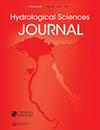Long-term precipitation prediction in different climate divisions of California using remotely sensed data and machine learning
IF 2.5
3区 环境科学与生态学
Q2 WATER RESOURCES
Hydrological Sciences Journal-Journal Des Sciences Hydrologiques
Pub Date : 2023-08-21
DOI:10.1080/02626667.2023.2248112
引用次数: 0
Abstract
ABSTRACT This study presented a novel paradigm for forecasting 12-step-ahead monthly precipitation at 126 California gauge stations. First, the satellite-based precipitation time series from Climate Hazards Group InfraRed Precipitation with Station data (CHIRPS), TerraClimate, ECMWF Reanalysis V5 (ERA5), and Precipitation Estimation from Remotely Sensed Information using Artificial Neural Networks-Climate Data Record (PERSIANN-CDR) products were bias-corrected using historical precipitation data. Four methods were tested, and quantile mapping (QM) was the best. After pre-processing data, 19 machine-learning models were developed. random forest, Extreme Gradient Boosting (XGBoost), extreme gradient boosting, support vector machine, multi-layer perceptron, and K-nearest-neighbours were chosen as the best models based on Complex Proportional Assessment (COPRAS) measurement. After hyperparameter adjustment, the Bayesian back-propagation regularization algorithm fused the results. The superior models’ predictions were considered inputs, and the target’s initial step was labeled. The next 11 steps at each station followed this approach, and the fusion models accurately predicted all steps. The 12th step’s average Nash-Sutcliffe efficiency (NSE), mean square error (MSE), coefficient of determination (R2), correlation coefficient (R) were 0.937, 52.136, 0.880, and 0.869, respectively, demonstrating the framework’s effectiveness at high forecasting horizons to help policymakers manage water resources.利用遥感数据和机器学习对加州不同气候区的长期降水量进行预测
本文章由计算机程序翻译,如有差异,请以英文原文为准。
求助全文
约1分钟内获得全文
求助全文
来源期刊
CiteScore
6.60
自引率
11.40%
发文量
144
审稿时长
9.8 months
期刊介绍:
Hydrological Sciences Journal is an international journal focused on hydrology and the relationship of water to atmospheric processes and climate.
Hydrological Sciences Journal is the official journal of the International Association of Hydrological Sciences (IAHS).
Hydrological Sciences Journal aims to provide a forum for original papers and for the exchange of information and views on significant developments in hydrology worldwide on subjects including:
Hydrological cycle and processes
Surface water
Groundwater
Water resource systems and management
Geographical factors
Earth and atmospheric processes
Hydrological extremes and their impact
Hydrological Sciences Journal offers a variety of formats for paper submission, including original articles, scientific notes, discussions, and rapid communications.

 求助内容:
求助内容: 应助结果提醒方式:
应助结果提醒方式:


